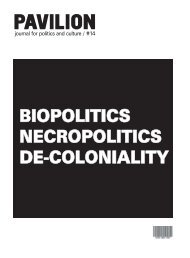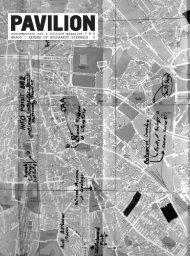PAVILION
PAVILION
PAVILION
- No tags were found...
Create successful ePaper yourself
Turn your PDF publications into a flip-book with our unique Google optimized e-Paper software.
Financial Imaginaries:<br />
Toward a Philosophy of the City<br />
[260]<br />
by Reinhold Martin<br />
For over a century, the social relations of<br />
the metropolis have been linked analytically<br />
to capitalist circulation, a link that is<br />
still clearly audible in the term “global<br />
city.” This applies in both the narrow,<br />
deterministic sense that would privilege<br />
the mechanisms of techno-economic<br />
globalization, and in the broader, more<br />
inclusive sense that would assign to<br />
social and cultural processes a semistructural<br />
role in shaping the pulsations<br />
and interchanges of economic life. In<br />
either sense, the city itself seems to<br />
stand as a receptacle, a sort of archaeological<br />
site for holding these dynamics in<br />
place long enough and firmly enough to<br />
study them in all their complexity.<br />
This scenario was inherited in part from<br />
the great thinkers of modern, metropolitan<br />
experience, from Simmel to Weber to<br />
Benjamin, with Marx and Engels just over<br />
the horizon. Their cities, Berlin and Paris,<br />
with London, Moscow, and New York just<br />
outside the frame, gave the term<br />
“metropolis” its phenomenological texture.<br />
For his part Benjamin, reading<br />
Baudelaire, was able to imagine the<br />
Parisian arcades as paradigmatic of the<br />
circulation of both commodities and<br />
dream images through the interstices of<br />
“modern life,” primarily through the literary<br />
device of allegory. This insight would<br />
eventually be inverted and transformed in<br />
that same city into the Situationist dérive,<br />
with the help of which a later cohort of<br />
urban thinkers, from Lefebvre to De<br />
Certeau, would draw their lines in the<br />
sand: sous les pavés, la plage.<br />
But this tradition, which extracted general<br />
principles from what late twentieth century<br />
urbanists would eventually call the<br />
“historical center” of European cities (for<br />
which the barricades of May 1968 are an<br />
ironic emblem), has become a rather<br />
quaint, if not entirely irrelevant, vantage<br />
point from which to approach the “world<br />
around” dynamics of today, to borrow a<br />
term from the idiosyncratic lexicon of<br />
Buckminster Fuller. We can let Fuller<br />
stand here as a late representative of the<br />
counterproposition, incipient in modern<br />
architecture and urbanism and thoroughly<br />
manifest in mid-century modernization<br />
discourse and the policies and practices<br />
that it generated, that the modern city<br />
was a node in a much larger network that<br />
could only be apprehended and managed<br />
from above. Just as the inside-out,<br />
bottom-up view of the city and of modernity<br />
in general, from Benjamin to the<br />
Situationists, was enabled by technologies<br />
of perception that ranged from the<br />
reading glasses of the dandified, pedestrian<br />
flâneur, to the plate glass in which<br />
the arcades were enclosed, to the vividly<br />
painted panoramas that destroyed perspective<br />
and enfolded distant horizons,<br />
so too did the aerial, eventually planetary<br />
view have its technical media. These also<br />
had partial roots in the European nineteenth<br />
century, in aerial photography (as<br />
Benjamin intuited) and in imperial cartography,<br />
but they would only be fully<br />
expressed in the multi-screen, computerized<br />
war rooms of the Cold War, mirrored<br />
in the control rooms of NASA or the<br />
Soyuz programs, and eventually miniaturized<br />
in GIS and Google Earth.<br />
The globe, as a dynamic object of perception<br />
and manipulation quite distinct<br />
from its antecedents in the history of cartography,<br />
is a prerequisite for the concept<br />
of globalization, and the design problems<br />
that it generates, from the problem of<br />
visualizing in real time the rapid pulsations<br />
of “world around” financial markets<br />
to the problem of predicting long term<br />
weather patterns, are its materialization.<br />
However, it is important to recognize that<br />
historically, our two vantage points, from<br />
the street and from the control room,<br />
develop simultaneously rather than in<br />
sequence. Though it may be tempting,<br />
therefore, to assign to each a valence—<br />
negative for the dominating, leveling perspective<br />
from above, positive for the situated,<br />
everyday perspective from below—<br />
and hence to oppose them as two terms<br />
in a dialectic of modernization, we would<br />
do better to recognize the inherent limitations<br />
of the analytical frame thereby<br />
described.<br />
This requires a theorization of media that<br />
exchanges the eschatology of a<br />
McLuhan or, for that matter, the millenarianism<br />
of a Baudrillard or a Virilio, for the<br />
rigorous materialism generally associated<br />
with the term “archaeology” as elaborated<br />
by Foucault and others. The<br />
archaeological perspective, which<br />
emphasizes the interaction between<br />
ways of seeing and ways of knowing,<br />
[261]








